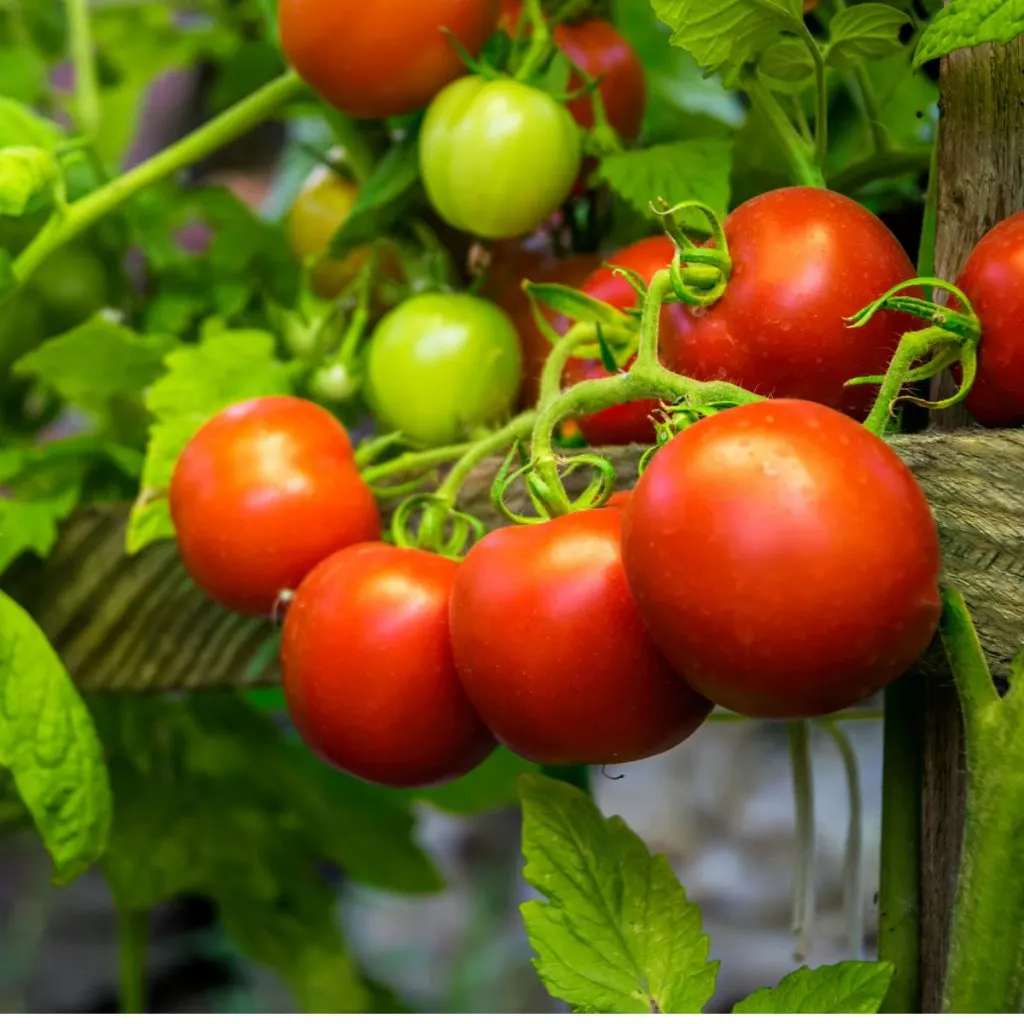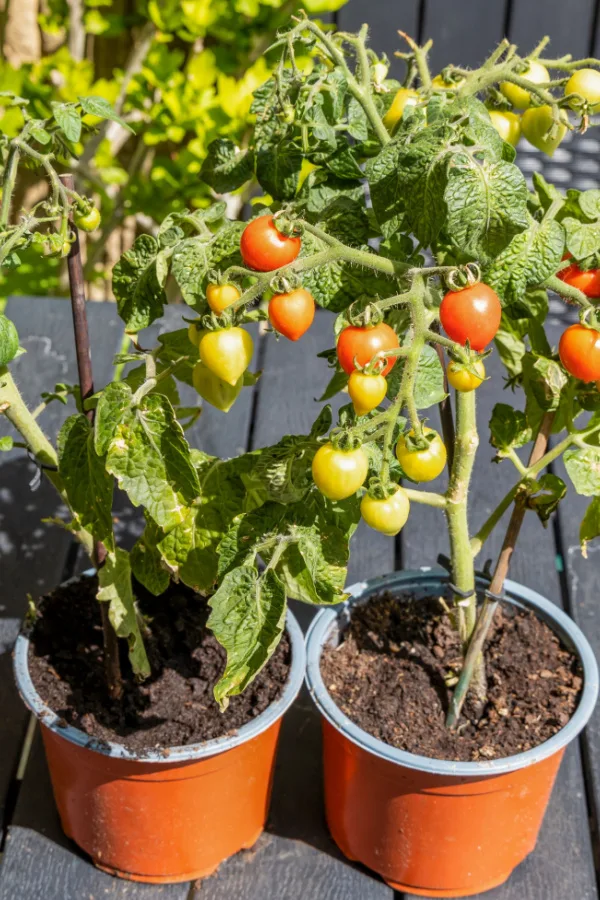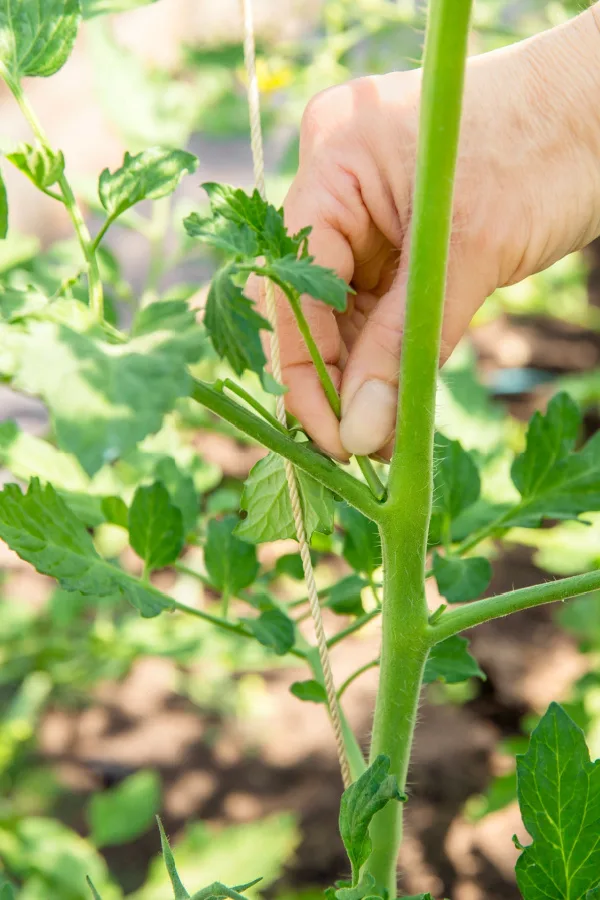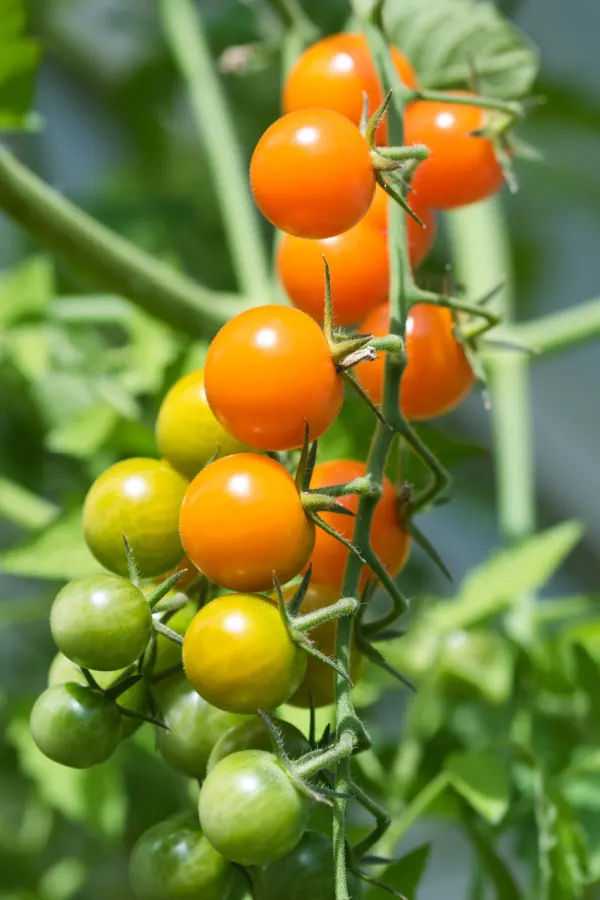If there is one thing that confuses gardeners more than anything else when growing tomatoes – it’s knowing the difference between determinate vs indeterminate tomatoes – and knowing which type is better for them to grow!
From tiny cherry tomatoes to large, one-pound slicing varieties, there are so many different types of tomatoes on the market these days that it can certainly be overwhelming. In addition to size, there are all kinds of differences in shape, colors, acid levels and more.
Add then, of course, there is the question of a tomato being an indeterminate or determinant variety. But what does that really mean? Does it really make that big of a difference when growing?

The answer is yes, it does make a big difference whether or not a tomato is one or the other. The good news is that both tomato types are wonderful for growing. And at the end of the day, deciding which type is best for you all comes down to knowing how you want to use the tomatoes you harvest.
Determinate Vs Indeterminate Tomatoes
The first step to knowing which type of tomato is best for you to grow is to know the difference between determinates and indeterminates – and the advantages of growing one over the other in your garden space. Let’s first take a look at determinates:
What Are Determinate Tomatoes?
Determinate tomato plants only grow to a certain size and then they stop. This results in their fruit all being mature and ready for harvesting within a shorter time frame. Determinate tomatoes are a great choice if you have a shorter growing period since they typically are ready for harvesting sooner than indeterminate varieties.
All tomatoes are essentially vining plants. However, determinate tomato plants tend to grow more compact and bush-like compared to their taller cousins.

Advantages Of Determinate Tomatoes
Determinate tomato plants are a popular choice for gardeners whose end goal is canning or processing large batches of tomatoes all at once. Since most of the fruit is ripe at the same time, determinates are perfect for turning into sauces or juices.
Another advantage of determinate tomatoes is that they take up way less space compared to indeterminate varieties. They are perfect for those limited in space – or if you want to grow tomato plants in containers or pots.
Most determinate varieties only grow to a max of four feet tall, but this can vary. However, some dwarf determinate varieties only grow to a foot tall. These mini tomato plants are great for growing indoors year-round as well. (See, “How To Grow Tomato Plants Indoors – Even In The Winter!”)
Another great advantage to these bush-like varieties is that they don’t often need to be trellised or caged. While using supports is still recommended to keep the plants off the soil, their sturdy stems help to keep plants more upright.
Another great aspect of determinate tomatoes is they rarely need pruning compared to indeterminate varieties. Other than removing the bottom few branches up to the first fruiting stem, no additional pruning is needed. In fact, pruning above this space will actually cause a reduction in fruiting.
Listen In Below To Our Podcast To Learn How To Prune Your Tomatoes For Big Success This Year!
One final note on determinates – when they are done producing – they are done! Many who grow determinates think their plants have a disease or issue in mid to late summer when they begin to die. As a determinate, the plant has simply run its course.
What Are Indeterminate Tomatoes?
On the flip side are indeterminate tomatoes. These types of tomatoes continue to grow and produce fruit throughout the growing season. In fact, healthy indeterminate plants will continue to produce blooms and fruit right up until the first frost.
Unlike their smaller cousins, indeterminate tomato plants need to have some sort of support, cage, or trellis system. Since the plants continue to grow, their long vines can easily reach 10 feet or longer if allowed to grow at will.
Unlike determinate tomatoes, indeterminate tomatoes benefit from proper pruning to help keep the plants from becoming too unruly. As the plants grow, they produce suckers. Removing these suckers and only allowing two to three main stems to continue to grow will result in healthier plants and bigger fruit.

Advantages Of Indeterminate Tomatoes
The advantage of growing indeterminate tomato varieties is that you continually get a good harvest of fresh fruit. This makes these varieties popular for fresh eating all summer long. The harvests overall are not smaller than the production levels of determinate plants, but are instead spread out over a longer period of time.
You can still use indeterminate tomatoes for canning. Since the fruit of indeterminate tomatoes isn’t all ripe at the same time, you can refrigerate or freeze what you harvest until you have enough to process a large batch of tomatoes at once.
Most heirloom and larger slicing varieties of tomatoes are indeterminates. A great advantage of heirloom plants is that you can save the seeds from their fruit to grow new plants the following year. All, of course, for free!
Popular Determinate & Indeterminate Varieties To Grow
Below is a look at some of the most popular of each type of tomato to grow. We have included seed links with each for those looking to start their own plants indoors.
Popular Determinate Varieties – Determinate Vs Indeterminate Tomatoes
Early Girl Bush – A hybrid variety that produces multiple large fruit that mature early on low-growing plants. Affiliate Link : Early Girl Bush Tomato Seeds

Roma – A classic and popular heavy-producing paste tomato that is perfect for making sauces and tomato juice. (Affiliate Link: Roma Seeds)
Tiny Tim – A dwarf variety that grows to only 12” tall and produces small cherry tomatoes. It’s perfect for growing in containers indoors or for growing on decks and patios. (Affiliate Link: Tiny Tim Seeds)
Popular Indeterminate Varieties – Determinate Vs Indeterminate Tomatoes
Cherokee Purple – An heirloom beefsteak tomato variety that produces intense-flavored dark purple slicing tomatoes. (Affiliate Link: Cherokee Purple Seeds)
San Marzano – A heavy producing heirloom paste tomato plant that produces clusters of good-sized tomatoes. Popular for canning or creating purees. (Affiliate Link: San Marzano Seeds)

Sungold – An early producing cherry tomato plant that produces low-acid, sweet golden yellow tomatoes in large yields. Affiliate Seed Link: Sun Gold Tomato Seeds
Unsure Of Which Plant You Are Growing?
If you have a plant already growing in your garden but you aren’t sure which type of plant it is, there are a few ways you can identify it.
First, look at its growth habit. If the plant is continually pushing out new growth long into the season, then chances are it is an indeterminate variety. If the plant has started to produce fruit but has slowed growth, it’s likely a determinate variety.
You can also look at the placement of the flowers. Look at the end of the tallest growing stem. If the tip has leaves at the end, it is likely an indeterminate plant. If the tip has flowers instead, it is likely a determinate plant.
The flower clusters and eventually fruit of a determinate plant are usually located at the end of the stems. In contrast, the fruit of an indeterminate plant continues to grow past the point of fruit production.
Whether you grow them by seeds or by transplants, knowing if your tomato plants are determinate or indeterminate varieties will allow you to provide the best care and support each plant needs, resulting in an amazing harvest of delicious fruit this summer!
Follow Our Facebook Page For Even More Great Tomato Growing Tips! I Grow Tomatoes Facebook Page
I Grow Tomatoes is a website created for those who love all things about tomatoes – from planting and growing – to cooking and canning! We publish two articles every week, 52 weeks a year. Sign up today to follow via email! This article may contain affiliate links.
